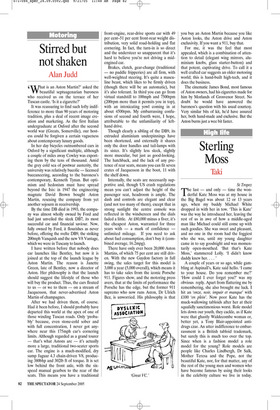Stirred but not shaken
Alan Judd
‘What is an Aston Martin?’ asked the beautiful septuagenarian baroness who received us on the terrace of her Tuscan castle. ‘Is it a cigarette?’ It was reassuring to find such lofty indifference to more than 90 years of motoring tradition, plus a deal of recent image creation and marketing. As the first Italian undergraduate at Oxford after the second world war (Greats, Somerville), our hostess could be forgiven a certain vagueness about contemporary luxury goods.
In her day bicycles outnumbered cars in Oxford by a significant multiple, although a couple of miles away Cowley was exporting them by the tens of thousand. Amid the grey cold sea of postwar austerity, the university was relatively bucolic — licensed buccaneering, according to the baroness’s contemporary, Kenneth Tynan. But optimism and hedonism must have spread beyond the Isis: in 1947 the engineering magnate David Brown bought Aston Martin, rescuing the company from yet another sojourn in receivership.
By the time DB died in 1993, the company was almost wholly owned by Ford and had just unveiled the sleek DB7, its most successful car and financial saviour. Now, fully owned by Ford, it flourishes as never before, offering the svelte DB9, the striking 200mph Vanquish and the new V8 Vantage, which we were in Tuscany to launch.
I have written before that nobody does car launches like Bentley, but now it is joined at the top of the launch league by Aston Martin. The reason is Janette Green, late of Bentley, now a director of Aston. Her philosophy is that the launch should suggest the lifestyle of those who will buy the product. Thus, the cars floated to us — or we to them — on a stream of Jacquesson, that never-advertised Aston Martin of champagnes.
After we had driven them, of course. Had it been before, I should probably have departed this world at the apex of one of those winding Tuscan roads. Only ‘probably’ because, even stone-cold sober and with full concentration, I never got anywhere near this 175mph car’s cornering limits. Although regarded as a grand tourer — that’s what Astons are — it’s actually more a large, traditional two-seater sports car. The engine is a much-modified, dry sump Jaguar 4.3 chain-driven V8, producing 380bhp and 302lb ft of torque. It is set low behind the front axle, with the sixspeed manual gearbox to the rear of the seats. This means you have a traditional front-engine, rear-drive sports car with 49 per cent–51 per cent front-rear weight distribution, very solid road-holding and flat cornering. In fact, the turn-in is so direct and the understeer so unapparent that it’s hard to believe you’re not driving a midengined car.
Brakes, clutch, gear-change (traditional — no paddle fripperies) are all firm, with well-weighted steering. It’s quite a masculine beast, which likes to be firmly driven (though there will be an automatic), but it’s also tolerant. In third you can go from virtual standstill to 100mph and 7500rpm (200rpm more than it permits you in top), with an intoxicating yowl coming in at about 4500rpm. My embarrassing confusions of second and fourth were, I hope, attributable to the unfamiliarity of lefthand drive.
Though clearly a sibling of the DB9, its extruded aluminium underpinnings have been shortened, and externally it shares only the door handles and tail-lamps with its sister. It’s slightly less sleek, slightly more muscular, but just as good-looking. The hatchback, and the lack of any pretence of rear seats, means you can fit seven crates of Jacquesson in the boot, 11 with the shelf down.
Internally, the seats are necessarily supportive and, though US crash regulations mean you can’t adjust the height of the passenger seat, headroom is ample. The dash and controls are elegant and clear (and not too many of them), except that in strong sunlight the centre console was reflected in the windscreen and the dials faded a little. At £80,000 minus a fiver, it’s the cheapest Aston, warranted for three years with — a mark of confidence unlimited mileage. If you need to ask about fuel consumption, don’t buy it (combined average, 16.2mpg).
There have only ever been 20,000 Aston Martins, of which 75 per cent are still driven. With the new Gaydon factory in full swing, the sales target for this model is 3,000 a year (5,000 overall), which means it has to take sales from the iconic Porsche 911. Figures show, and the motoring press avers, that at the limits of performance the Porsche has the edge, but the former 911 supremo who now runs Aston, Dr Ulrich Bez, is unworried. His philosophy is that you buy an Aston Martin because you like Aston looks, the Aston drive and Aston exclusivity. If you want a 911, buy that.
For me, it was the feel that most appealed, which is a combination of attention to detail (elegant wing mirrors, aluminium knobs, glass starter-button) and that potent, captivating drive. To call it a well crafted car suggests an older motoring world; this is hand-built high-tech, and it does the business.
The cinematic James Bond, most famous of Aston owners, had his cigarettes made for him by Morlands of Grosvenor Street. No doubt he would have answered the baroness’s question with his usual courtesy. Very similar bits of kit, he’d have assured her, both hand-made and exclusive. But the Aston burns just a wee bit faster.
































































 Previous page
Previous page